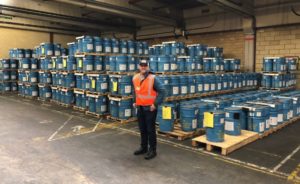Trade disputes could be negative for certain metal prices

Anthony Milewski, Chairman and CEO of Cobalt 27 Capital, at the company's cobalt warehouse in Rotterdam, the Netherlands. Photo courtesy Cobalt 27 Capital Corp.
By Peter Kennedy

The strong global economic growth expected in 2018 should be synonymous with higher industrial metal prices, according to a new commodity trends report by Desjardins Group.
The view was supported this week by news that China’s vast manufacturing sector grew at the fastest pace in eight months during the month of May, exceeding expectations and easing concerns about an economic slowdown.
However, the Desjardins report was issued just before Canada and Mexico unveiled retaliatory measures against the United States’ decision to slap tariffs on steel and aluminum imports, a move that reignites fears of a global trade war.
A 25% tariff on steel imports and a 10% tariff on aluminum imports will be imposed on the EU, Canada and Mexico from midnight Friday (June 1, 2018), said U.S. Commerce Secretary Wilbur Ross.
Canada has pledged to hit back by imposing tariffs covering $16.6 billion on imports from the United States, including whiskey, orange juice, steel, aluminum, and other products.
Before those measures were announced, Desjardins warned in its May 29, 2018 report that some risks associated with as yet unresolved trade disputes might have a negative impact on prices in certain cases by reducing trade between countries or a positive impact on others by limiting supply.
Here is what Desjardins had to say about the outlook for the major base metals, and cobalt.
Aluminum.
On April 6, the United States announced sanctions against Russia, targeting among others United Company Rusal Plc, an aluminum producer. Fears of a serious aluminum deficit as a result of these sanctions caused aluminum prices to shoot up to a peak of US$2,450 per tonne. After the sanctions were eased, prices fell but remained high at close to US$2,250 per tonne. Tensions on the aluminum market continue, as China and Japan are still subject to the aluminum and steel tariffs introduced earlier this year and as the tariff exemption deadline for other countries is drawing near. Furthermore, the United States asked the European Union to reduce its aluminum and steel exports to the United States by 10% from 2017 levels. The continuing uncertainty surrounding aluminum and the sustained demand for this metal have kept prices high. Given its already high level, prices may remain fairly steady, but news of trade disputes or sanctions could continue to cause large swings.
The US aluminum tariff will hit Rio Tinto’s aluminum smelter in Kitimat on the northwest coast of British Columbia as it sells most of its metal to the US.
Copper
Copper prices show no clear trend. The recent decrease in LME inventories does not appear to have affected prices, meaning that the market does not believe it reflects a real shortage. The rising US dollar and bond yields have certainly weighed on copper prices as well. Having started the year off on a strong note, copper is now sitting in negative territory with a loss slightly above 4% since early 2018. However, it is showing significant growth compared to last year. The market seems fairly balanced at this time, and there appears to be no indication that this will change in the near term
Zinc
Zinc prices have been on a negative trajectory after peaking at US$3,600/tonne in February when inventories began to increase. However, it is worth noting that the price had reached an unsustainable level and a retreat was inevitable. It was recently just above US$3,000/tonne: more than 9% lower compared with the beginning of the year. Prices could continue to fall given a return to equilibrium in the global zinc market.
However, even though a number of newcomers are starting production this year, the zinc market is expected to remain tight.
Nickel
An uptrend in nickel prices has been noted since mid-2017, putting the metal above US$14,500/tonne, over a 17% gain since the beginning of January 2018. The considerable decline in inventories appears to support this growth. They have now reached the level they were at in June, 2014 when the price was US$5,000/tonne higher. The strong demand expected for 2018 and 2019 could cause inventories to continue to shrink and prices to rise.
Cobalt
A more secondary metal recently saw its price nearly quadrupled from 2016. Cobalt has grown widely in popularity because of the growth in the electric vehicle market. This increase could lead mining companies to invest in copper and nickel mines since it is mainly from such mines where cobalt is extracted.
On May 22, Cobalt 27 Capital Corp. [KBLT-TSXV; 270-FSE] said it had acquired a cash-flowing cobalt-nickel stream on the producing Ramu Mine. Ramu is located near Madang on the north coast of Papua New Guinea.
Cobalt agreed to acquire a stream of over 55% and 27.5% of Highlands Pacific Ltd.’s attributable share of cobalt and nickel production, respectively, from the Ramu Mine in exchange for a $145 million upfront deposit.
